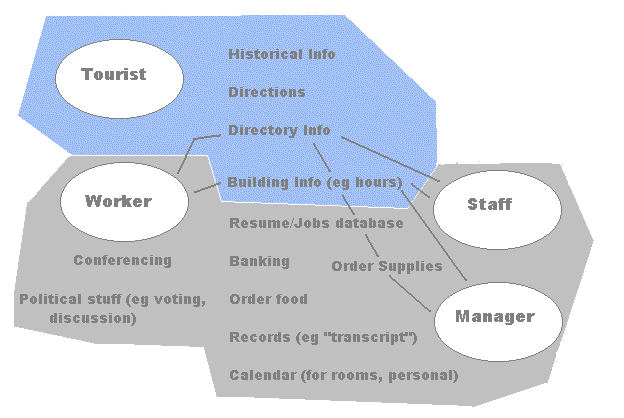Point of Need Computing
- What places are convenient (where do people "stand
around" alot; where do they stand when they wait
for, eg, the printer; where are they when they need to
perform tasks?
- Are there thought experiments which can help to
identify these places?
- Are there real experiments which can help to
identify these places?
- Why do people go back to their offices? Are any of those
needs solvable using appropriately placed kiosks?
- we go back to send someone email when we discover
they're not in.
- we go back to write down an appointment
- we go back to ...
- What areas function as community areas, and can kiosks
help with community tasks in those areas?
- the copy room, meeting rooms, coffee rooms,
stairwells, entryways, hallways
- Access messages
(esp. urgent) stored in email, voice mail, ...
- Directory
Information (finding someone or
something)
- Documents
(viewing, printing, records, ...)
- Games
(eg treasure hunt)
- Information
Presentation ("About"
button)
- Internet phone(talking to people) Since there will almost always be
a telephone available, this seems unnecessary.
- Leave notes/send
notes (an electronic bulletin board)
- Ordering Supplies
- Phone Forwarding This
involves some cross architecture work that is beyond the
scope of this summer's project.
- Printing job
control
- Reporting
problems, errors, etc
- Scheduling
- Screen Saver
(?)
- Suggestion Boxes
(add, discuss, and vote on suggestions)
- Other Scenarios
Right now we are considering several different hardware platforms. We will
probably use the Windows95 operating system. For our interface,
we plan to use a combination of cgi-bin scripts, HTML, and java.
This will (hopefully) be easily accessible both from the desktop
environment and the PALplates.

Objects have properties. Directory, Notes, Suggestion Boxes,
etc all pick objects based on who's near, what's near, and
where's near, not just one of them.
Web based, probably.
Two different approaches discussed so far:
- A combination of cgi-bin scripts for accessing a database
of different interface configurations, and java code for
providing functionality beyond what a normal HTML page
provides. The database outputs HTML files. The interface
is done using large images for buttons, etc, but can be
viewed from any browser.
- A mud back end, with an internal model of the office
building. A java-based mud client provides the interface.
This is very similar to the previous approach, but the
need for cgi-bin scripts is circumvented completely.
Copyright © 1996 FX Palo Alto Laboratory,
Inc. For problems or questions regarding this web contact Jen
Mankoff. Last updated June 20,
1996.

